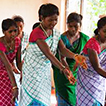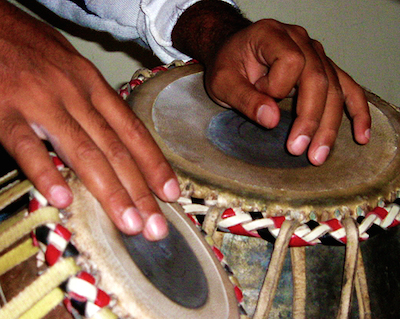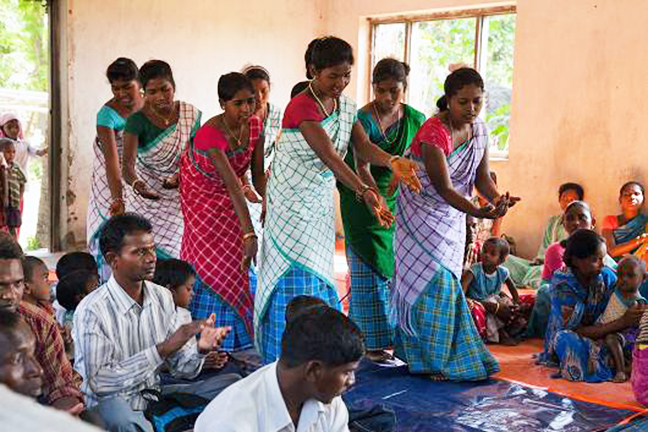Indigenized Christian Worship in India
Some Considerations

One of the greatest challenges of the Indian Christian church is its Western heritage. Most mainline denominations follow a Westernized liturgy and music in their worship. When missionaries came to India they translated the Bible and their own hymns into the local languages for use in worship. But now even a century later, churches still use the same hymnal and the translated Book of Common Prayer for worship. In addition, the Indian church has largely adopted Western pews and postures, with newer generation churches increasingly adopting songs from Euro-American contemporary Christian music, making the worship of the church even more Western. With that in mind, I would like to propose in this article some possibilities toward further indigenization of Christian worship in India.1
WESTERNIZED WORSHIP AND MUSIC
Because of linguistic limitations, missionaries were not able to make a translation that fits well to the common use of the language. Problems in syllables and structures make it almost impossible for people to understand the texts of many songs. But over the years there have been no attempts made to retranslate the Book of Common Prayer or the hymns, or to create a liturgy that is relevant in the Indian context. Although many Indian Christians wrote songs reflecting their theology in Indian terms, churches rarely took the initiative to use them in worship. Use of the indigenized liturgies was limited to the seminaries and ashrams. The only musical instrument that was allowed in the church was organ; only the Catholic, Pentecostal and Charismatic churches attempted to use some of the indigenous musical instruments for worship. At Christmas time, churches in South India use hymns that talk about winter and snow—when the temperature is 80° F and the people have never seen snow!
WESTERNIZED POSTURE
Another significant aspect that the Indian church lost in worship was the posture of worship. In most Indian religions worshipers sit on a thick mattress spread on the floor. People sit on the floor, with their legs crossed, as an expression of their respect to their deity. During the time of prayer they kneel, with their heads bowed to the ground. But the Christian churches accepted the Western form of sitting on pews for worship. According to the Hindu tradition no one may enter the place of worship unclean or wearing sandals. But Christian churches do not emphasize these aspects in their worship. In the mind of an Indian these show a lack of respect and devotion to God.
WESTERNIZED LANGUAGE
Due to the limitations of the missionaries’ language understanding, the liturgies and the translated hymns do not match the common usage of the language. The language used in the church is much different from the common language. It is not unusual to see the Christians being mocked by people of other religions for the strange form of language that was used in the church. Dayanand Bharati, a leading Christian theologian, says about the language in church:
Where are Christians who can speak in languages familiar to the people? If a new believer ever goes to a church service, he cannot even understand the message, not to mention all the other activities of the church. If he wants to survive among them, then he must become conformed to their image in all the areas of his life. But the church will remain Westernized and will not be bothered about either the new believers or the common people yet to be reached with the gospel.2
WESTERNIZED PREACHING
Preaching in Indian churches is also influenced by the western heritage. Indian churches typically use an elevated pulpit or a preaching stand. In recent years, influenced by the charismatic preaching seen on international Christian television channels, the preacher tends to move around on the pulpit and preach very loud in his attempt to imitate the Christianity viewed on the television. But in Indian tradition, teachers of the scriptures sit on the floor on a slightly elevated place with the scripture open in a small book holder. The name of the Hindu scriptures, upanishads, is a word picture of this aspect of teaching in Indian context. Upanishad means the inner, or mystic, teaching. The term upanishad is derived from upa (‘near’), ni (‘down’) and s(h)ad (‘to sit’): that is, sitting down near. Groups of pupils sit near the teacher to learn from him. This does not match with today’s Christian preaching.
 CHANGE OF FOCUS FROM EVANGELISM TO WORSHIP
CHANGE OF FOCUS FROM EVANGELISM TO WORSHIP
I believe one of the greatest needs today is a change of focus in indigenization. Until now, the primary motivation behind indigenization was to attract more people to the church. That motivation has sometimes caused people of other religions to think that the Christians are faking something to make Christianity more attractive. Attempts at indigenization in the area of mission have given a negative picture of Christianity as a kind of “wolf in sheep’s clothing.”3
This attitude will change only if the church changes from its roots. Before attempting indigenization in missions outreach, the church’s worship must become indigenized. Over the years, churches used indigenous methods to evangelize the world, while keeping all the Westernized forms in the worship. In my opinion, the church should change for the sake of worshiping God in the language and culture of the people, not simply to attract more churchgoers. As American pastor John Piper says:
Missions is not the ultimate goal of the church. Worship is. Missions exists because worship doesn’t. Worship is ultimate, not missions, because God is ultimate, not man. When this age is over, and the countless millions of the redeemed fall on their faces before the throne of God, missions will be no more. It is a temporary necessity, but worship abides forever.4
To make the indigenization authentic and meaningful, the church needs to initiate radical changes from the center: that is, in their worship. Then indigenized missions will flow naturally from the indigenized worshiping church.
INDIGENIZATION FROM GRASS ROOTS UPWARD
If we look at the past indigenization movements in India, we note that they were primarily movements initiated by large denominations, many times still under Western leadership. In this way, “indigenous liturgies” were created for all of South India or North India. However, a country like India with 4693 people groups can never have one unified contextualized liturgy appropriate for the whole Southern States. It has to become an attempt of local churches under the leadership of local believers from the grass roots of the culture. Only people of each local region will know what is appropriate for them in worship.
WORSHIP POSTURE
Christian churches should consider returning to Indian heritage in their worship styles. Churches might leave their pews behind and follow the more typical Indian style of sitting on the floor and praying while kneeling. This worship posture may even draw the worshiper closer to the original meaning of the word worship as it is used in the Bible. The Hebrew word hištahªwâ, translated as “worship,” literally means “to bend oneself over at the waist.”5 I find it fitting to adapt worship posture from Indian traditions. This posture may be more acceptable to Christians as a way of remaining Indian, while showing their homage and submission to the Christian God. Bharati, for example, expresses his desire for an Indian style of worship posture after attending a Westernized worship service:
I often dreamed in this way—remove all the Western musical instruments, and also even the pulpit; spread a dari (thick carpet) on the stage, have one bhajan [one form of worship music in Indian tradition] team lead in singing beautiful bhajans; the, how we could all worship the Lord in spirit and truth!6
Expression of homage, devotion, and awe in the presence of God can be expressed by removing sandals and cleansing oneself before entering the worship space.7
LANGUAGE OF WORSHIP
The language of worship needs to become more culturally understandable, creating a new liturgy with awareness and understanding of aspects of Indian culture. Even if churches continue to use their Western liturgies—for example, based on the Book of Common Prayer—they can be translated into the common (vernacular) languages of the people.
It is also important to develop indigenous terminologies to teach Christian doctrine. William Carey and his team developed Sanskrit terms for their biblical translation, providing a set of standard Sanskrit terms for the theological education of future generations.6 The contemporary church needs to continue to seek out these culturally relevant terms for theological concepts. Using Indian words to explain Christian doctrine will lead people to a better understanding of their faith, and that understanding will lead to clearer, more appropriate worship.
ARCHITECTURE OF THE WORSHIP SPACE
The architecture of the worship space is another area that might be indigenized. Today most of the mainline Christian worship spaces are imitations of Western structures, ignoring the significance of appropriate architecture altogether. Many churches do not have a theological understanding about the structure of place in worship. For the Hindu worshiper, temple structure carries great religious significance. Hindu temples are constructed according to very specific, intentional plans. Each aspect in the temple has some kind of religious significance. This architectural awareness could be adapted to Christian churches. What would it look like to have a Christian theological perspective on architectural design? St Mary’s Church in Nagercoil, South India, which claims a historical link to St Thomas, is an ancient example of the Christian adaptation of Hindu architecture.10
 ROLE OF MUSIC
ROLE OF MUSIC
Music plays a very important role in the indigenization of worship. The church has tended to use Indian songs only for evangelism, and Western songs in their congregational worship. As I suggested above, I believe the idea of indigenization and change in the church should begin with the church’s worship, rather than specifically with its outreach to others. The common music styles of the people, such as bhajans and keerthans, could be given a place in corporate worship. This is the music that every Indian hears early in the morning from the temples. These forms, originating in the Hindu bhakti (devotion) traditions, are easily adaptable for congregational use. The leader sings one phrase of the song and the congregation repeats that phrase with the accompaniment of small cymbals. Many of the psalms and other biblical passages could work very well as bhajans.11 Many Christians in Indian cannot ever imagine Indian music being used effectively in worship, because they have never seen or experienced it. It is important to provide them with venues to experience worship with indigenous music and other art forms so that they can experience it for themselves.
Another musical possibility is the reconfiguration of the hymns into Indian musical forms. Hymns carry a rich theology from throughout the history of the faith, and they can be used effectively in Indian contexts by connecting them to indigenous melodic forms and adapting the lyrics appropriately.
ROLE OF READING THE SCRIPTURES
Preaching plays a very important role in making the gospel relevant to the people. Timothy C. Tennent talks about making the gospel culturally relevant:
[T]he gospel is not only linguistically translatable, it is culturally translatable. The gospel is not only delivered to us in the enscripturated text, but also in the proclamation and witness of a believing community, the members of which belong to a particular culture at a particular time in history.
Preachers should carefully consider the methods by which the gospel can be shared through culturally relevant terminologies. This can be done cautiously, lest extreme adaptation of cultural terms mislead people in wrong theological directions. Scripture plays a very significant role in Hindu temple worship. There are days throughout the week when Hindu worshipers read from the scriptures. Although Hinduism does not have preaching sessions as part of corporate worship, Christians could consider how to give importance to the Bible by devoting significant time to hearing it read.
WHOLE LIFE AS WORSHIP
Bharati, himself a convert from high caste Brahmanism, talks about Indian and Hindu attitudes to worship like this:
Worship is the pivot on which the entire spiritual life revolves, particularly for Hindus. They never worship just three hours [Sunday worship usually lasts three hours] in a week plus (bonus) one house prayer meeting.
This holistic concept of worship fits well with a biblical Christian understanding of worship in all of life. Indian Hindus are accustomed to pooja (prayers) early in the morning, at their homes or in the temple. This habit can become a part of the Indian Christian’s life as well.
Family plays a very important role in the religious life of India. Devoted Hindu families start their day by cleansing themselves and doing pooja in the small worship place built into their house. This concept also can be transferred well in Indian context by emphasizing the importance of family worship and prayer at their homes. In that way all of life can be emphasized as worship.
CONCLUSION
Indigenization of worship needs to proceed with caution, and with fidelity to the Bible. Lack of biblical and theological understanding can result in serious flaws. It is not an attempt to appear like other religions of the country or to compromise with other religious faiths. Bharati says, “Contextualization is not compromise, nor conforming to the image of the world, but rather allowing the gospel to become incarnate in the existing culture in faithfulness to the Bible.”14
Marva Dawn offers a good criterion to evaluate our attempts for indigenization: “We make use of the cultural forms, new and old, but we dare never let up in the struggle to make sure they are consistent with the ultimate eternal world to which we belong.” 15 That ultimate eternal world, according to Rev. 7: 9-10, includes a future of peoples worshiping God with the unique cultural gifts he’s given them. This is a future worth “worshiping toward” 16—a future in which all of India’s people groups will have a new song to sing before the throne of the Lamb.









comments